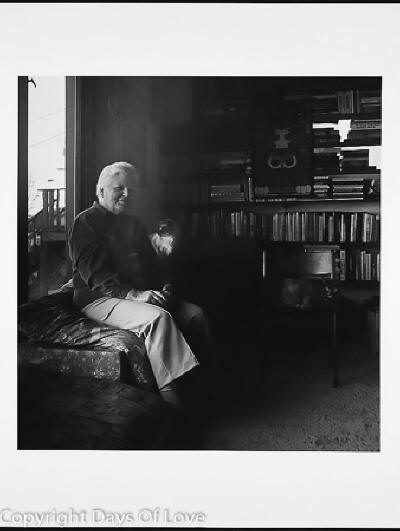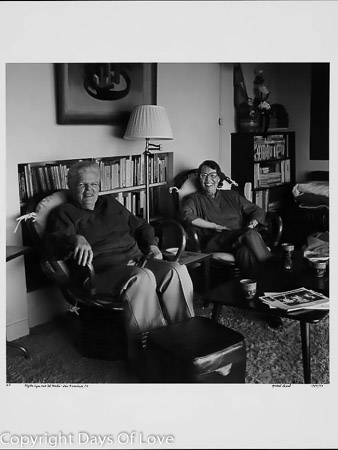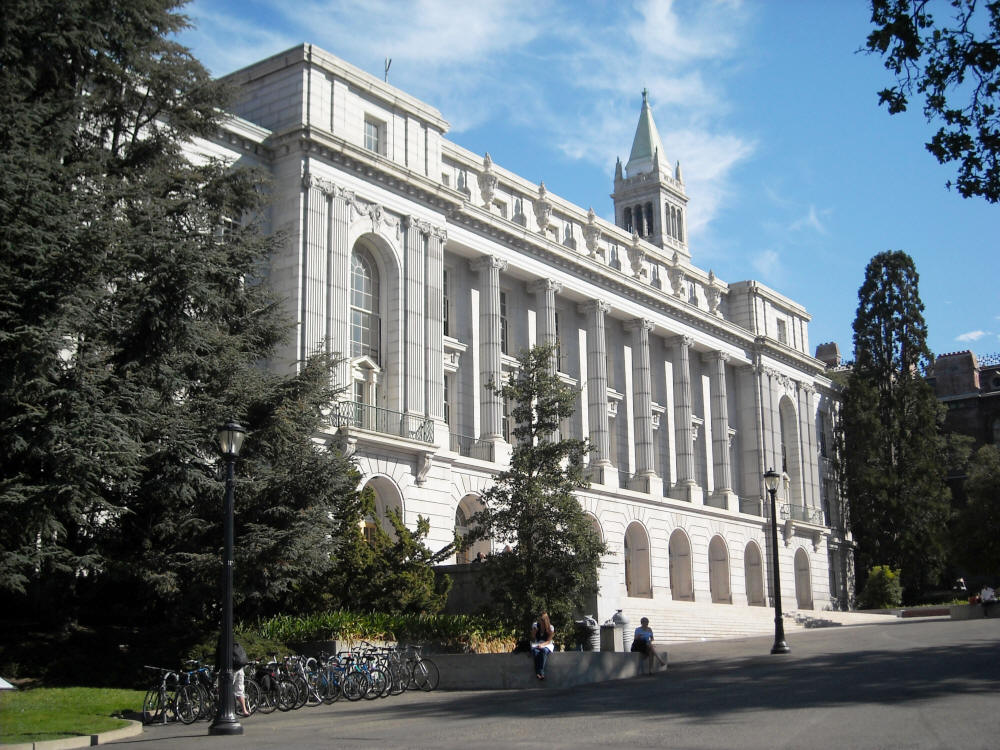

Wife Phyllis Lyon
Queer Places:
University of California, Berkeley, CA
651 Duncan St, San Francisco, CA 94131, Stati Uniti
 Del Martin (May 5, 1921 – August 27, 2008), born Dorothy Louise Taliaferro in
San Francisco.
Del Martin (May 5, 1921 – August 27, 2008), born Dorothy Louise Taliaferro in
San Francisco.
Del Martin and Phyllis Lyon are profiled in ''Family: a portrait of gay and lesbian America'', by Nancy Andrews (1994) and ''Living happily ever after: couples talk about lasting love'', by Laurie Wagner, Stephanie Rausser, and David Collier (1996).
The Daughters of Bilitis (pronounced be-LEE-tus and abbreviated DOB) began in 1955 in San Francisco as a middle-class social club for lesbians wishing to avoid the bar scene. Rose Bamberger, a Filipina American, had the initial idea for the group and enlisted the aid of her partner and three other lesbian couples. Phyllis Lyon and Del Martin were one of the couples, and they are more famously associated with the group’s founding. Historians credit Lyon and Martin with switching the group’s focus from socializing to organizing and educating. In 1956, the group began publishing The Ladder, a magazine focused specifically on lesbian lives. Many of the most well-known female activists of the pre-Stonewall gay and lesbian movement—Lyon, Martin, Kay Tobin (Lahusen), and Barbara Gittings—held leadership positions within DOB at one time or another, as did a number of lesbians of color, including Cleo Bonner, Ernestine Eckstein, and Ada Bello.
Martin was the first salutatorian to graduate from George Washington High School. She was educated at the University of California, Berkeley and at San Francisco State College, where she studied journalism, and she earned a Doctor of Arts degree from the Institute for Advanced Study of Human Sexuality. She was married for four years to James Martin and retained his name after their divorce.[4][5] She had one daughter, Kendra Mon. Martin died on August 27, 2008, at UCSF Hospice in San Francisco from complications of an arm bone fracture. She was 87 years old.[1] Her wife, Phyllis Lyon, was at her side. San Francisco mayor Gavin Newsom ordered that the flags at City Hall be flown at half-staff in her honor.[6]
In 1977, Martin became an associate of the Women's Institute for Freedom of the Press (WIFP).[7] WIFP is an American nonprofit publishing organization. The organization works to increase communication between women and connect the public with forms of women-based media.
Dorothy Louise Taliaferro "Del" Martin (May 5, 1921 – August 27, 2008)[1] and Phyllis Ann Lyon (born November 10, 1924) were an American lesbian couple known as feminist and gay-rights activists.[1]

Featured in
Particular Voices: Portraits of Gay
and Lesbian Writers by Robert Giard [Rights Notice: Copyright Jonathan G. Silin
(jsilin@optonline.net)]

University of California, Berkeley, CA
Martin and Lyon met in 1950, became lovers in 1952, and moved in together on Valentine's Day 1953 in an apartment on Castro Street in San Francisco. They had been together for three years when they founded the Daughters of Bilitis (DOB) in San Francisco in 1955, which became the first social and political organization for lesbians in the United States. They both acted as president and editor of The Ladder until 1963, and remained involved in the DOB until joining the National Organization for Women (NOW) as the first lesbian couple to do so.
Both women worked to form the Council on Religion and the Homosexual (CRH) in northern California to persuade ministers to accept homosexuals into churches, and used their influence to decriminalize homosexuality in the late 1960s and early 1970s. They became politically active in San Francisco's first gay political organization, the Alice B. Toklas Democratic Club, which influenced then-mayor Dianne Feinstein to sponsor a citywide bill to outlaw employment discrimination for gays and lesbians. Both served in the White House Conference on Aging in 1995.
In 1980, Bruce Voeller commissioned Don Bachardy to create a series of portraits of twelve leaders of the gay and lesbian rights movement. The subjects included Voeller, Phyllis Lyon, Del Martin, Frank Kameny, Barbara Gittings, Troy Perry, Jean O'Leary, Charles Brydon, James Foster, David Goodstein, Morris Kight, Elaine Noble. Many were high-profile business-people, politicians, and publishers as well as influential activists. Bachardy’s partner Christopher Isherwood privately referred to Voeller’s circle as the ‘Gay Elite’. Sittings were largely arranged in Bachardy’s home town of Los Angeles, although a handful were done during a trip he made to New York in October 1980. Following Voeller's death, Lucik presented the portrait series to the Human Sexuality Collection, Cornell University, in 1995.
Lyon and Martin were married on February 12, 2004, in the first same-sex wedding to take place in San Francisco after Mayor Gavin Newsom ordered the city clerk to begin providing marriage licenses to same-sex couples, but that marriage was voided by the California Supreme Court on August 12, 2004. They married again on June 16, 2008, in the first same-sex wedding to take place in San Francisco after the California Supreme Court's decision in In re Marriage Cases legalized same-sex marriage in California.[2] In August 2008 Martin died from complications of an arm bone fracture in San Francisco.[3]
Phyllis Lyon, sixty-eight, and Del Martin, seventy-one, are best known as two of the eight women who founded the Daughters of Bilitis in 1955. At the time there were two other gay groups in the United States: the Mattachine Society and ONE, Inc. Daughters of Bilitis was the first exclusively les¬ bian organization. Chapters spread across the nation, and the group flourished in the 1960s, holding national conventions and garnering the attention of the mainstream media and the FBI. The na¬ tional organization dissolved in 1970. Today, only the Boston chapter remains. The two continue to work for women's and gay rights. They coauthored Lesbian/Woman in 1972, and Del wrote Battered Wives in 1976. The couple of more than forty years first met when they worked for construction-industry trade pub¬ lications in Seattle, Washington. Del was the first person Phyllis had ever met who she knew was a lesbian. They later moved to San Francisco, and they still live in the house they bought there in 1955. Del is divorced, with one daughter and two grandchildren. The two were photographed with their cat, Koala, in their kitchen. Phyllis: We had a phone call from one lesbian. She wanted to know if we would be inter¬ ested in helping to start a social group for lesbians. So we said yes. Del: Everybody was very isolated and closeted. It was difficult to find people to join. We came up with the name Daughters of Bilitis so we would sound like a women's lodge— Daughters of the Nile or Daughters of the American Revolution—and nobody would know that it was a lesbian group. Phyllis: Some had wanted to make it like a women's lodge where you would have ritual membership induction and things along those lines. The rest of us didn't really go for that idea exactly. Another woman brought the Songs of Bilitis to our attention. It was a lesbian narrative poem. She felt that lesbians would know what Daughters of Bilitis meant, but nobody else would. Of course, I don't think most of the lesbians knew what it meant ei¬ ther. We had never heard of this poem. We decided we needed a newsletter. With the very first issue we had about 175 copies before the Mattachine Society's mimeograph broke down. A lot of members of DOB didn't use their real names. I became Ann Ferguson. I was editor of The Ladder, our newsletter. I guess it was the idea that my name was going to be in print, and I thought, "Somebody might see it and God knows what would happen, so I'd better not do that." So I took my middle name and my mother's maiden name. Then at the same time we started the newsletter in 1956, we started our public discussion meetings. We rented a room downtown, and people could just come by. People would want to meet Ann Ferguson because they'd seen The Ladder so they'd want to meet the editor. So Del would yell, "Ann Ferguson! Ann! Ann!" And I would never respond, because it wasn't my name. Then she'd say, "Phyllis!" and I would turn right around. So we decided that the pseudonym thing was really ridiculous, and we killed Ann Ferguson.
My published books: